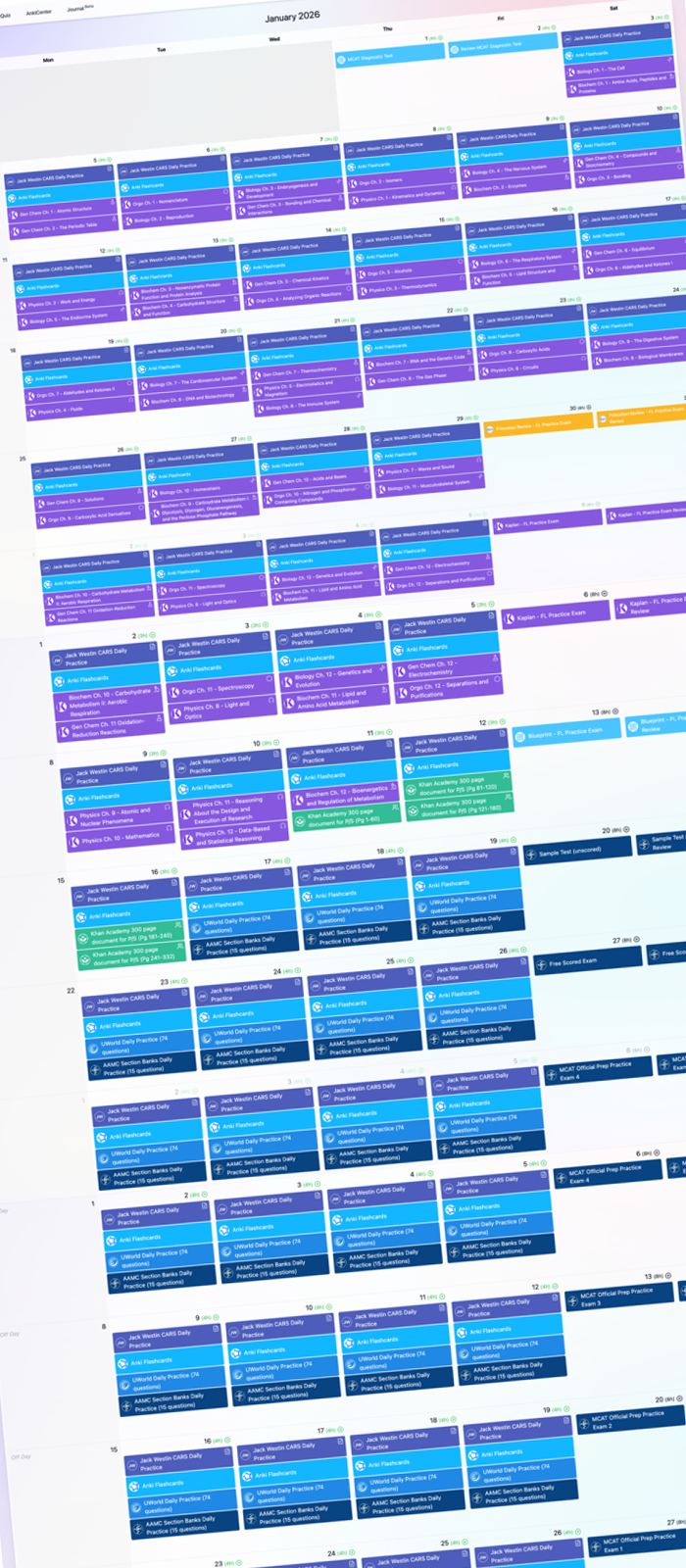3-Month MCAT Study Plan: Aggressive But Realistic Timeline
Published on Nov 12, 2025
3-Month MCAT Study Plan: Aggressive But Realistic
A 3-month MCAT study plan is intense, but totally doable if you have solid prerequisites and can stay consistent. Most students following a plan like this study 20–30 hours per week, aiming to reach the recommended 250–300 total hours in a short timeframe.
This guide shows you exactly how to structure your 3-month plan and includes a real sample plan created in MCAT.tools so you can see what it looks like in practice.
Who a 3-Month Plan Is Best For
A fast-paced 3-month plan works well if you:
- Recently completed your science pre-reqs
- Can study 20–30 hours per week
- Learn well through practice
- Prefer structure and momentum
- Can avoid long stretches of missed days
If you’re rusty on science content or have a heavy course load or job, a longer plan (4–6 months) may feel more manageable.
The Overall 3-Month Structure
A 3-month plan moves quickly, so the structure matters. It’s broken into three phases:
Phase 1 (Weeks 1–4): Content Review + Light Practice
This phase rebuilds your foundation. Because time is limited, content review is more targeted and should be rotated (Bio → Chem → Psych → CARS → repeat) instead of doing one subject at a time.
During this phase you will:
- Refresh the major topics from each subject
- Do light practice passages early
- Start CARS immediately (small daily sessions)
- Avoid deep dives that eat time but don’t improve your score
The goal is not perfect mastery.
It’s to get to a place where practice becomes productive.
Phase 2 (Weeks 5–8): Heavy Practice + Targeted Review
This is where most score growth happens. You’ll shift toward:
- More passage-based practice
- Timed mini-blocks
- Deep review of mistakes
- Targeted content refresh for weak areas
- Increased CARS volume
Instead of broad “review everything,” you now study what your mistakes reveal.
Phase 3 (Weeks 9–12): Weekly Full-Length Exams
Full-lengths are the highest-impact resource — and you should not use them early.
Here’s the correct approach:
- Take ONE diagnostic full-length early on
- Save all remaining full lengths for the final 6–8 weeks
- Take 1 full-length per week during this phase
- Spend the next session doing deep review
- Use your mistakes to guide targeted drills
This phase builds stamina, confidence, timing, and real test-day endurance.
Weekly Time Commitment
A typical 3-month schedule looks like:
- Mon–Thu: 2–4 hours per day
- Fri: Rest or a lighter session
- Sat: 4–6 hour anchor session
- Sun: Review or weekly full-length
If you’re working full-time, you’ll lean more heavily on weekends.
Real Example: 3-Month Plan Built in MCAT.tools
Below is a real sample 3-month study plan generated in MCAT.tools, using a mix of common resources (students can substitute whatever they prefer).
January (Weeks 1–4): Content + Light Practice
You begin with a diagnostic, then rotate subjects daily. Early passage practice starts almost immediately.
February (Weeks 5–8): Heavy Practice + Targeted Review
Practice becomes the core of your week. You introduce AAMC materials and start fixing weaknesses rapidly.
March (Weeks 9–12): Full-Lengths Every Week
Weekly full-lengths + thorough review dominate this month. Each FL creates targeted practice for the next week.
Daily Flow Examples
Phase 1 (Content-Focused Day)
- 45 min → Bio/Biochem content
- 45 min → Chem/Phys content
- 30 min → Psych/Soc
- 30 min → CARS practice
Phase 2 (Practice-Focused Day)
- 1 hr → Mixed passages
- 1 hr → CARS timed set
- 1–2 hrs → Reviewing mistakes + targeted refresh
Phase 3 (Full-Length Weeks)
Day 1: Full-length exam (7.5 hours)
Day 2: Full review
Days 3–7: Targeted drills + CARS + mixed practice
What to Do If You Fall Behind
Falling behind is common on a fast plan. Smart adjustments include:
- Shifting broad content review into targeted review
- Dropping low-yield tasks (long videos, over-reading)
- Using weekends for catching up
- Adding a buffer week before full-length season
The structure matters more than checking every single box.
How MCAT.tools Helps
MCAT.tools makes a 3-month plan far easier to manage by:
- Auto-generating your full study plan
- Distributing tasks logically across days
- Adjusting pacing automatically when weeks slip
- Allowing quick resource swaps
- Structuring the final 6–8 weeks around full-lengths
- Displaying your calendar just like the example above
You don’t have to manually plan 250–300 hours — the tool handles the structure for you.
Final Thoughts
A 3-month MCAT study plan is fast and demanding, but completely doable with structure and consistency. If you rotate subjects, move into practice early, and take full-lengths weekly in the final 6–8 weeks, you’ll be in a strong position on test day.
Short runway. Big discipline. Real results.

